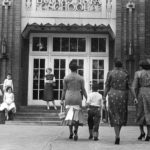It is now an independent socialist/communist state bordered to the east by the South China Sea, and to the west by Laos and Cambodia. Dominated by China for many centuries, it was ‘visited’ by the Portuguese in 1535. By the 17th century visits had also been made by Dutch, French and English traders accompanied by missionaries.
In 1802 the north and south were combined as The Vietnamese Empire, which in turn was conquered by French forces towards the end of the century. The French Indo-Chinese Union with Cambodia and Laos was formed in 1887.
Inevitably, during the Second World War the country was invaded successfully by the Japanese, and there followed an occupation during which a certain amount of industrialization took place, but agriculture remained the basic staple by which the people of Vietnam were fed.
The Viet Minh under Ho Chi Minh fought for independence from France in the Indo-China War (1946-54). After the Battle of Dien Bien Phu which the French lost, they withdrew, leaving a Communist Democratic Republic in the North, and the ‘State’ of Vietnam in the South. Civil war broke out, however, in 1964. This led to US intervention on South Vietnam’s side in 1965. Before the First World War, American interventions in Europe and the Far East were unheard of, US citizens preferring to deal with threats nearer their own coasts. When the 2nd War hit Europe, it was touch and go whether or not the States would intervene, or even assist. The attack on Pearl Harbor (q.v.) without a declaration of war by Japan decided the matter but America had waited for more than two years (September 1939 – December 1941).
The idea behind the States’ intervention in the Far East was to stop the spread of Communism, a frightening political spectre for Americans of both Republican and Democrat bent. More and more ‘military advisers’ arrived to provide aid for South Vietnam. The North replied by attacking US ships waiting in the surrounding seas. President Johnson then ordered specialised bombing of specific targets in North Vietnam. It was like hitting a bulging hornets’ nest with a stick.
Oddly enough, the US Congress did not declare war, but did authorize its forces in South East Asia to repel any armed attack, and prevent further aggression. Bombing, now less precise in its targeting, was increased, and by 1968 more than half a million US soldiers were involved one way or the other in the War. By and large, the great European nations made use of their own form of ‘Monroe Doctrine’ and did not become involved in any important way.
The peculiar conflict dragged on and on, with one side the most powerful nation on earth deploying unheard-of strength in a previously almost unknown peninsula; on the other side, at least according to American and European news reports sent by correspondents, those fighting were small, lightly armed and wore black pyjamas. Perhaps what had not been taken into account were three desperately important factors: First, the North Vietnamese believed their war was legitimate and patriotic; second, the South Vietnamese might well have preferred Communism, and certainly did not take to American soldiery, superior fire power or no; third, the Chinese were supplying advice, war aid, technology, money and everything else except soldiers – to America’s enemies, as they had done during the British/Malayan Emergency some years before.
Victory seemed to be unattainable. The more the Americans killed determined little Asian men the more appeared, thin but fighting fit. Napalm bombs and the latest jet fighters seemed to make little impression. Back home in the USA the War’s unpopularity increased ten-fold, with singers, film directors, actors and other artists standing up to be counted among the War’s strongest opponents. They were soon joined by the American press.
Pressures across the American continent increased, and almost everyone wanted the useless, and in the opinion of some, uncalled for war to end. In 1968 peace negotiations began in Paris, but not until 1973 was a ceasefire agreement signed though the war continued effectively until two years later, when victory for North Vietnam was assured by the capture of Saigon, leading to American humiliation and withdrawal. Two hundred thousand South Vietnamese left the country following defeat of South Vietnamese forces and, by implication, the United States.
After the collapse of Soviet Communism in 1991, the newly united Socialist Republic of Vietnam improved its relations with the USA. A new Constitution was adopted in 1992 that backed many economic and political reforms, but even now all effective rule is Communist in ideology and practice.












Leave A Comment